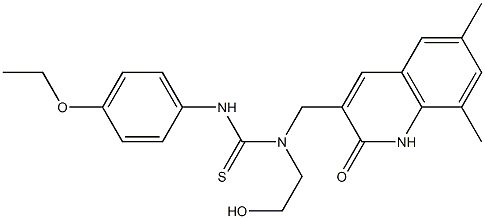β-Glucuronidase-IN-1
Modify Date: 2024-01-09 23:03:02

β-Glucuronidase-IN-1 structure
|
Common Name | β-Glucuronidase-IN-1 | ||
|---|---|---|---|---|
| CAS Number | 484006-66-8 | Molecular Weight | 425.54378 | |
| Density | N/A | Boiling Point | N/A | |
| Molecular Formula | C23H27N3O3S | Melting Point | N/A | |
| MSDS | N/A | Flash Point | N/A | |
Use of β-Glucuronidase-IN-1β-Glucuronidase-IN-1 is a potent, selective, uncompetitive, and orally active E. coli bacterial β-glucuronidase inhibitor, exhibiting an IC50 and a Ki of 283 nM and 164 nM, respectively[1]. |
| Name | 1-((6,8-dimethyl-2-oxo-1,2-dihydroquinolin-3-yl)methyl)-3-(4-ethoxyphenyl)-1-(2-hydroxyethyl)thiourea |
|---|
| Description | β-Glucuronidase-IN-1 is a potent, selective, uncompetitive, and orally active E. coli bacterial β-glucuronidase inhibitor, exhibiting an IC50 and a Ki of 283 nM and 164 nM, respectively[1]. |
|---|---|
| Related Catalog | |
| Target |
IC50: 283 nM (E. coli β-glucuronidase) Ki: 164 nM (E. coli β-glucuronidase)[1] |
| In Vitro | β-Glucuronidase-IN-1 (Inhibitor 1) (0.01-100 μM) inhibits E. coli β-glucuronidase activity as a dose-dependent manner and exhibits an IC50 and a Ki value with 283 nM and 164 nM, respectively[1]. β-Glucuronidase-IN-1 (100 μM; 24-72 hours) maintains potent efficacy in living bacterial cells (EC50=17.7 nM), it does not affect bacterial cell growth under aerobic or anaerobic conditions or killing mammalian epithelial cells[1]. Cell Viability Assay[1] Cell Line: CMT93, CaCO-2, HCT116 cells Concentration: 100 μM Incubation Time: 24 hours, 48 hours and 72 hours Result: Did not impact mammalian cell survival and any reduction in cell viability were attributed to the presence of DMSO. |
| In Vivo | β-Glucuronidase-IN-1 (oral gavage; 10 μg; twice per day; 11 days) protects the mouse GI epithelium from CPT-11–induced damage and protects the glandular structure of CPT-11-treated intestinal tissues[1]. Animal Model: Healthy 6- to 8-week-old Balb/cJ mice[1] Dosage: 10 μg Administration: Oral gavage; twice per day; 11 days Result: Alleviated CPT-11-induced toxicity in mice. |
| References |
| Molecular Formula | C23H27N3O3S |
|---|---|
| Molecular Weight | 425.54378 |